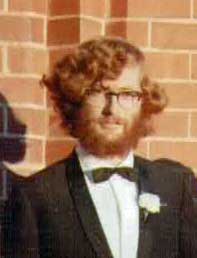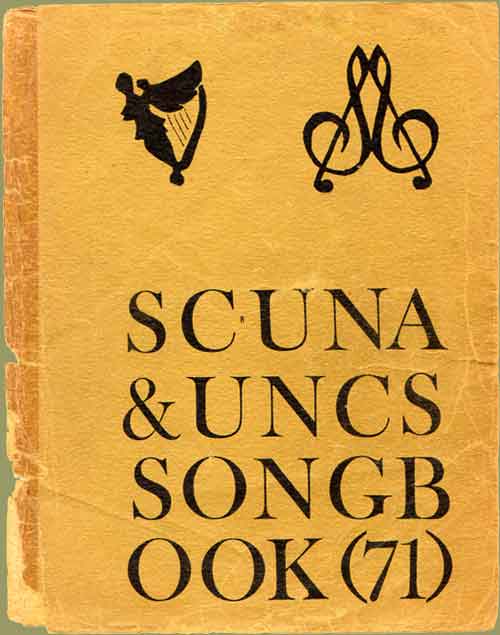
SCUNA history 1963-1988:
The SCUNA & UNCS Songbook
SCUNA history » The SCUNA & UNCS Songbook
The songbook is an essential commodity, an invaluable asset at parties, O‑week concerts, Bush Week Parades etc. etc.
- Richard Dixon, Oyez of 5 November 1972
Download the original SCUNA Songbook
Also on this page: Origin | Cover | Table of Contents | Editions | Notes
An email interview with Hartley of Garran Hall, member of SCUNA 1967-1971, and editor of the original and best[1] SCUNA songbook. My questions and interpolations appear in italics. - Val T

What inspired you to create the SCUNA songbook?
My muse.
Also, so that SCUNA (and also UNCS) had a songbook of our own songs similar to the SUMS songbook.
UNCS: The University of NSW Choral Society, now defunct.
SUMS: The Sydney University Musical Society.
The SUMS songbook: see Appendix.
As a valedictory salute to SCUNA. By that time, I was only a drinking (no longer singing) member[2] of SCUNA.
It also gave me a break from studying the cohomology of groups, which was what I was supposedly doing at Sydney at the time.
How accurate/relevant is the following statement (which I made up)?
From its founding in 1963, SCUNA gave increasingly frequent concerts and developed quite a repertoire of choral works. The choir grew so much in membership and enthusiasm in the late 1960s, under Chris Burrell's conductorship, that a songbook was called for.
Sounds reasonable, though I am not sure who was calling for it.
How much input did UNCS have?
Not a lot, really. It was really me and the Kays.
How did you select works to be included?
Mainly they were pieces that we knew from SCUNA. I added a few pieces that I particularly liked (like the Wilbye Lady your words do spite me. Also As t'other day Susan and Man is for the woman made, which I had heard on a record and transcribed).[3]
Then we also had the great honour to be the first (and I believe only) publishers of the epoch-defining Kay-Kay-Bonnefin arrangement of the immortal Milligan song[4]. An opportunity not to be passed up.
Looking at the table of contents, can you cross your heart and swear that you didn't deliberately put favourite songs on special page numbers? For example:
| Sewers of the Strand |
Kay/Kay/Bonnefin |
64 [26] |
| Sicut cervus |
Palestrina |
81 [34; square of a square] |
| and all the songs on prime numbers? |
I am not quite sure what you mean by special page numbers. My main concern with layout was to put certain songs on the middle pages, so that they could be removed (ripped out) when I sent a copy of the songbook to my mother.
Or were they all favourite songs?
All favourites, I think.
Does the following statement (which I made up) bear any relation to the truth, and if so, what?
It was all handwritten, much of it by Hartley, but some of it also by Robert Kay, who was responsible for the little pieces of Celtic art scattered through the songbook.
Also some pieces written by Maureen Corbett. The rest seems right.[5]

From the imprint of the first edition, July 1971
The significance of the egg in the boot would probably be lost on most. See above remark re "valedictorian".[6]
QUMS held an Intervarsity Choral Festival in 1965, SUMS held one in 1967, and SCUNA held its first in 1971. These were also the years they first produced their songbooks.[7] Do you think there's any link?
QUMS: The Queensland University Musical Society
Not that I am aware.
How did you choose Better Printing Queanbeyan [who did an excellent job, by the way]?
Not sure. I think that Paul Pentony had something to do with it.
Have you anything to declare? 
Ooh, it's good to be alive.[8]
The cover of the first edition

Note:
- the UNCS logo on the left,
- a stylised version of the SCUNA logo on the right,
- a tiny "R" in SC-UNA, and
- unconventional but modish layout of the word "songbook".
| Ad dominum cum tribularer |
Heinrich Schutz |
53 |
| All at once well met |
Thomas Weelkes |
10 |
| Amo amas |
Anon. |
46 |
| As t'other day |
Anon. |
43 |
| Au joly boys |
Clement Jannequin |
18 |
| Ave verum corpus |
William Byrd |
58 |
| Cantate Domino |
Claudio Monteverdi |
5 |
| Celia |
John Hunt |
44 |
| Ce Moys de May |
Clement Jannequin |
20 |
| Come again, sweet love |
John Dowland |
72 |
| Crucifixus |
Claudio Monteverdi |
16 |
| Der Gärtner |
Hugo Distler |
85 |
| Emily Emily |
Traditional |
22 |
| Fine Knacks for Ladies |
John Dowland |
74 |
| Incontinent que j'eu oui |
J.P. Sweelinck |
50 |
| Innsbruck |
Heinrich Isaac |
86 |
| Lady your words do spite me |
John Wilbye |
31 |
| Margôt labourez les vignes |
Jacob Arcadelt |
42 |
| Matona mia cara |
Orlando di Lasso |
68 |
| Meine Freunde mir Hilfe gibt |
Karl Johannes Röhe |
24 |
| Now is the month of Maying |
Thomas Morley |
14 |
| O occhi manza mia |
Roland Lassus |
66 |
| O sing joyfully |
Adrian Batten |
36 |
| Pase el agoa |
Anon. |
4 |
| Rejoice in the Lord alway |
John Redford |
26 |
| See the bold hussars! |
Matyas Seiber |
61 |
| Seigneur garde mon droit |
J.P. Sweelinck |
47 |
| Sewers of the Strand |
Kay/Kay/Bonnefin |
64 |
| Sicut cervus |
Palestrina |
81 |
| So ben mi ch'a bon tempo |
Horatio Vecchi |
40 |
| Strike it up tabor |
Thomas Weelkes |
41 |
| Tom |
Henry Purcell |
44 |
| Westron Wynde |
Traditional |
39 |
| While walking down the street |
Anon. |
45 |
| Yver |
Claude Debussy |
76 |
As one of the few car-owners in SCUNA at the time of the first edition of the songbook, I was given the task of delivering the copy to Queanbeyan for printing. Hartley asked me to proofread the pages beforehand which, in the middle of moving house and struggling with a major life mistake, I did not do. 
Two lots of staves turned out to be in the wrong order: one in the Palestrina Sicut Cervus (which we sang lots) and one in the Schütz Ad Dominum cum tribularer (which we sang often enough for it to matter).
The songbook was reprinted in August 1972 and again in August 1975. The transposed staves were corrected by the time of the 1975 reprint. I hope they were corrected for the 1972 reprint, but I was overseas from late 1971 till early 1976, so I don't know.
The Hartley SCUNA Songbook was reprinted in 1972, 1975, 1982 and 1989. In 1994, under editor Jon Price, an extensive revision took place: the songbook became an A4 volume, spiral bound, with 200+ pages. Elements of the Hartley songbook were retained. Another edition came out in 2003 to celebrate 40 years of SCUNA.
Notes
Please use your browser's Back function to return to the text
[1] ...and most portable, being a neat A5 size and 87 pages long.
[2] SCUNA won all the Boat Races that were held in 1971, including the "first formal individual title race" which was "won comfortably by Richard Hartley ... resplendent in gabardine raincoat and floral headband". [Peter Campbell, Laudate: the first 50 years of the Australian Intervarsity Choral Movement, PC Publishing, Canberra, 1999, p 141]
[3] I asked Hartley if he had included the Monteverdi Crucifixus, which we never sang, because it was on the programme of SCUNA's first concert (and, for that reason, featured in the 2003 SCUNA 40th Birthday concert). He said he hadn't known its SCUNA history; he had a recording of it and liked the piece.
[4] The immortal Milligan song is of course The sewers of the Strand. It originated in the Goon Show, Ten Snowballs That Shook The World (Series 8, Episode 20), and the Milligan recording can be heard on YouTube.
The presentation of the Kay/Kay/Bonnefin arrangement of The sewers of the Strand, aka Sideways, is one of the many triumphs of Hartley's SCUNA songbook. The work was premiered at the 1971 Intervarsity Choral Festival (Mittagong Camp Review) by some Sydney and Canberra folk with hankies on their heads.
Another significant performance occurred at the 1973 (?) Royal Leamington Spa Competitive Music Festival, given by Cantores ex SCUNA. See their page for a detailed description of the group, the competition, and (under the subheading Festival Shame) how The Sewers of the Strand was received.
Here's Hartley's take:
This august consort made a triumphant appearance at the Leamington Spa Eisteddfod ... about 1973-4 giving memorable performances of April is in my Mistress' Face and Sideways through the Sewers of the Strand. They received the highest mark for April and the lowest possible mark for Sideways, thus narrowly avoiding carrying off the trophy. The adjudicator made special (though unfavourable) mention of "the group that sang about the drains". This performance was no doubt the European premiere for the renowned Kay-Kay-Bonnefin composing triumvirate.
(By the way, I believe I was privileged to be their first (possibly only) publisher in the SCUNA-UNCS songbook.)
- Personal communication (group email), 2 December 2003
Sideways was preserved in the 1972, 1975, 1982 and 1989 reprintings of the songbook but tragically omitted from the 1994 and subsequent editions.
I am delighted to report that SCUNA nevertheless gave a spirited performance of Sideways at the National Archives of Australia on 27 and 28 February 2015, as part of the Enlighten Festival:
The fabulous ANU Choral Society (SCUNA) will regale you with songs of journeys and travel, reflecting the migration theme of the exhibition A Ticket to Paradise?
It was explained that a journey may take you to unexpected places!
[5] The imprint of the 2003 SCUNA songbook begins:
1971 edition perpetrated by Richard Hartley
(with Bob Kay, Maureen Corbett, and John Cunningham).
At that time Robert Kay was in SUMS, Maureen Corbett was in SCUNA, and John Cunningham was in UNCS.
[6] The egg in the boot symbolises valediction by illustrating the conclusion of a Goon Show poem called Scorflufus by Spike Milligan - the full poem is available online.
Turn the offer down flat,
Don your travelling hat,
Put an egg in your boot,
And beat it.
When Hartley left Canberra, he really did put an egg in his boot and beat it. I was there, outside the O'Connor shops late one night; I saw it happen. 
[7]Erratum: Trove lists a "Uni song book" published in Queensland in 1965 but this may not have been a QUMS songbook.
[8] Response by Eccles to the Customs Officer in the Goon Show, Under Two Floorboards (Series 5, Episode 18).
SCUNA History
This page created 2014; last updated 04 March 2015
SCUNA: home page |
Val: home page


![]()

